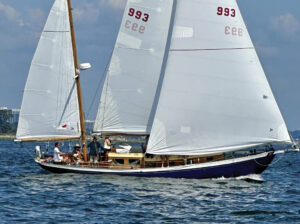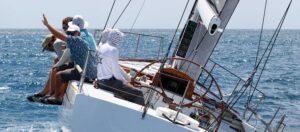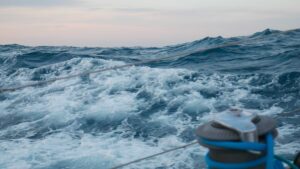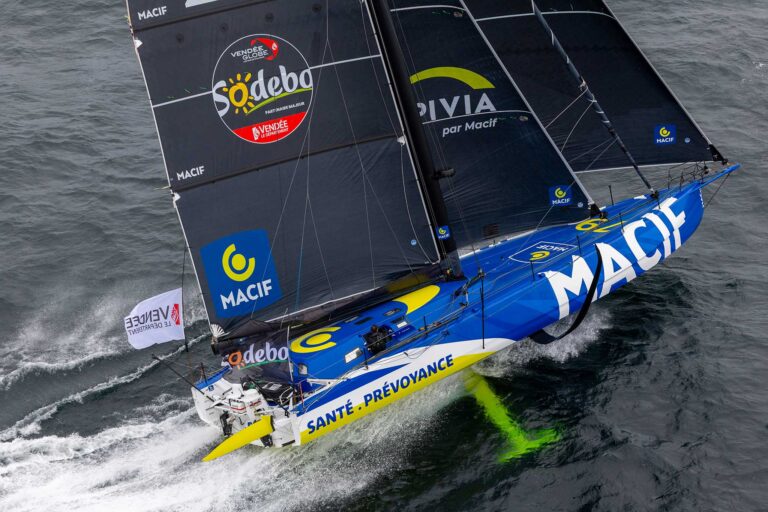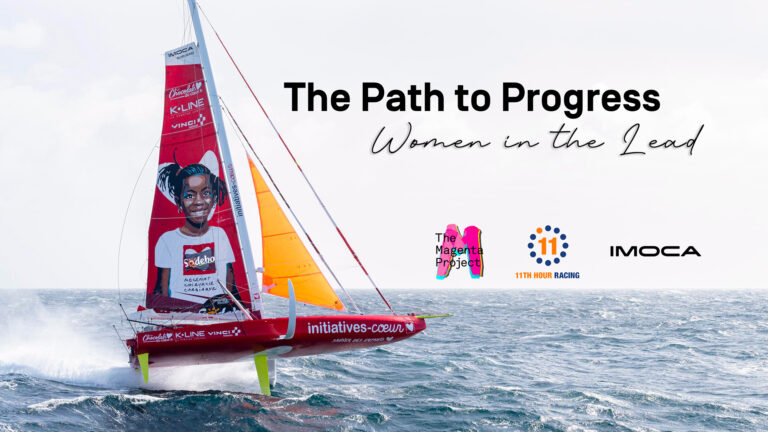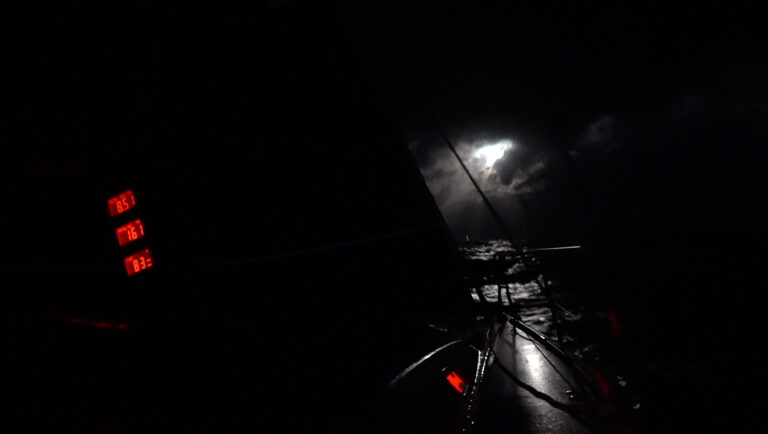I am pretty sure the Johnstone brothers never imagined creating anything so very successful as the J/Boats, Inc., that we know today. But imagining success on some level—that would come naturally to Rod, the designer and to Bob, the marketer. Long before J/Boats became the Johnstone family business, sailing was a family passion. Then came a case of left brain meeting right brain and—
Don’t worry. I’ll explain.
First I want you to picture a boat on Narragansett Bay, taking a little light spray on deck in winds of maybe 16 knots. The Rhode Island sky was bright. Rod Johnstone was on the helm, his hair silver and windblown above a navy windbreaker, and we were playing hooky from last year’s Newport boat show. Frankly, we deserved this. But the indefatigable Mr. Johnstone wasn’t about to get lost in the glory of a fresh breeze and forget to ensure that the journalist aboard was made aware of the virtues of the 41st J/Boats design. Rod’s new J/95, 31 feet long with twin rudders, has a draft of only 3 feet with its bronze centerboard raised. “This is an ‘interesting’ time,” he explained. “A down market is always a challenge. If people are going to buy boats, what are they going to buy? We’re betting they’ll buy smaller. This boat is versatile. There’s nothing else like it, certainly not on the used-boat market.”
He continued, “Along with the J/97 that Al [Rod’s youngest son] designed, these are the smallest boats we’ve done since the early 1990s. Boomers have retirement houses and they want to keep the boat at the dock, but how many docks have six feet of water? You can dock a J/95 in three feet of water. I think I know what boomers are going to want in five years. I ask, What do I want? Maybe that’s limiting, but there are people who agree with me that sailing and handling qualities come first. All our boats can tack through the breeze with just a jib. What we have here is a 31-foot boat that you can take out on a breezy day and be comfortable. You’re comfortable now, aren’t you?”
I couldn’t think of any place better to be, so I guess that was a yes. But I’ve always been curious about one thing. Johnstone designs in general please my eye, whether they’re by Rod or Alan, aka Al. But I really, really, really like the shape of those belowdecks doors. They’re a signature touch, and for whatever quirky reason, they fulfill my sense of pleasure at being on a boat, definitely on a boat, and nowhere else. But why that choice? “We were brought up in the days of wooden boats,” Rod says. “We like those touches.” Then the man adds, “I’ve always agreed with Nathanael Herreshoff that half the reason to own a boat is to look at it.”
Now let’s lift ourselves off the boat and meet some other members of the family, starting with Rod’s oldest son, Jeff, who became company president in 1988. “For us,” he says, “this is a way of life. I spent so much of my early years sailing J/24s, and then other Js, and then boats that my friends owned that we didn’t build, and it’s all so interwoven that it’s hard to know whether I’m working or not.”
What is J/Boats today? Think 11 current models from 24 feet to 43 feet, constructed by subcontractors in Europe and Asia and three builders in Rhode Island (Jeff says, “We feel strongly about Rhode Island boat building”). The company has more European input and output than ever, but is also looking to have a J/80 Worlds in Asia by 2016. Since 1977 the company has built 12,512 boats—spread over 42 different designs—and has been recognized by Fortune magazine for producing one of the top 100 American-built products. It has been profiled by the Harvard Business Review, yet operates from a modest, wood-frame building on Thames Street in Newport, Rhode Island: a world headquarters of five people. Rod’s middle son, Phil, is the legal counsel, and Alan is in-house designer with Rod as chief designer.
In 1988 Rod and his brother and business partner, Bob, moved themselves out of the J/Boats office and handed over day-to-day control to the next generation. Bob’s sons, Drake and Stuart, became vice presidents, along with Alan and Phil, in a stew of brothers and cousins. In the years since, there have been comings and goings and comings-back that are too complicated to follow here. In the big picture, however, the family business is still chugging along. “I’ve always thought of sailing as a way to bring a family together,” Rod says. “It’s worked for us in ways we never imagined.”
J/Boats also is a company that, historically, has grown stronger during “interesting times.”
He’s “Robert” on emails, but the world knows Bob Johnstone as Bob, right? He was around when his kid brother Rod (he calls him “Rodney”) was drawing pictures of boats in biology class. He’s sailed a heap, but today Bob has his own line of medium-sized motor boats, MJM Yachts, so I want you to picture me again on Narragansett Bay, again with a nice breeze and sunshine, but with nothing to do now but ride with Bob on a 34-footer that was designed to please the eye, please the hand, and please the water. As opposed to, ahem, maximizing volume. It’s a typical Johnstone exercise, even without mast and sails. Bob and I have talked often. This narrative encompasses many conversations, but on that day on Narragansett Bay, Bob was recalling the industry crisis of 1990, when the government imposed a 10 percent luxury tax on boats costing more than $100,000. “Sales stopped.”
That’ll get your attention.
But, “there is nothing so creative as a cornered rat.” Not long before, Bob had partnered with his son Peter (known these days for his Gunboat catamarans) and with Jay Cross in a 14-footer with an innovative retractable bowsprit. “So we thought, if 14-footers are manageable with a sprit, why not a bigger boat?”
Enter the J/105, an odd-looking beast in 1991. People weren’t accustomed to asymmetric spinnakers, and the 105 was not immediately a hit. Jeff says, “Again, we spent more time educating than selling.” But the 105 launched the sprit-boat revolution. The boats started to move, nurturing class racing paid huge rewards, and 681 have been sold to date. The price was no accident—just under $100,000—and the J/105 redefined the company in more ways than one. First, it proved you could sell a 35-foot raceboat without standing headroom or frilly accommodations. Second, says Bob, “We started using decimeters to name new models because, by then, we’d done so many boats in that size range we were running out of numbers in feet. We figured we’d never run out of numbers in decimeters.”
According to Bob, “the underlying brand strategy was to maintain ‘the best performing’ sailboat brand, similar to what Rossignol had done in skiing back in the mid-1970s. It hadn’t been done in sailing. Our competitors all had initial racing success, then succumbed to dealer pressure to load their boats with cruising amenities. That diminished their share of the performance market. Ultimately, J/Boats became ‘the performance brand’ with a 30-60 percent share of entries in just about every major raceweek.”
Optimism pervades J/Boats, Inc., today, just as in ‘91, when the 105 launched into its own down market.

